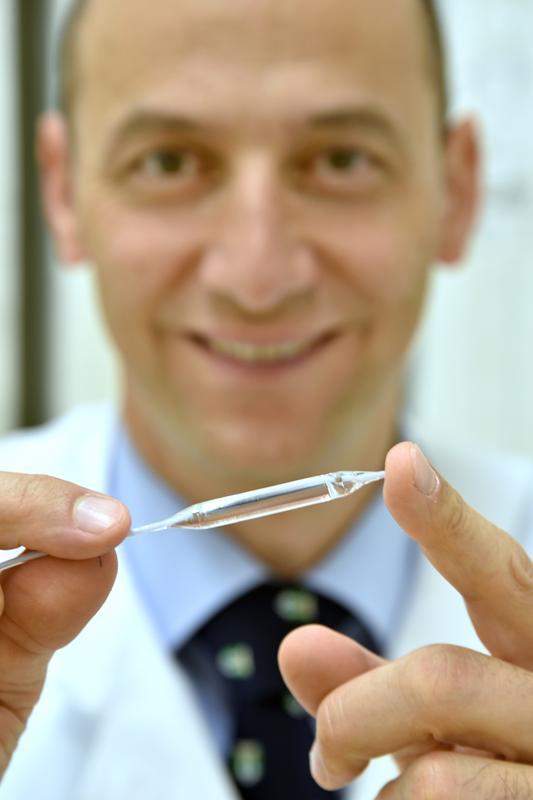Benefit and risk: Meta-analysis draws a heterogeneous picture of drug-coated balloon angioplasty

In a meta-analysis recently published in EClinicalMedicine, radiologist Ulf Teichgräber from Jena University Hospital draws a heterogeneous picture of drug-coated balloon angioplasty. Michael Szabó/Jena University Hospital
For intermittent claudication, drug-coated balloon angioplasty is the therapy of choice to reduce the risk of target lesion restenosis, and consequently, the necessity of reintervention. However, numerous types of those balloons are distinguished by drug density and coating.
Clinical efficacy is not proven for all that types. Moreover, conflicting evidence exists about the risk of mortality that arose from the meta-analysis of Katsanos et al. one year ago.
Scientists of Jena University Hospital, Germany, now conducted a meta-analysis sought to evaluate benefit and risk of drug-coated balloon angioplasty compared to non-coated balloon angioplasty assessing the main outcomes of freedom from target lesion revascularisation and all-cause mortality. Their results are published by THE LANCET in EClinicalMedicine.
The authors working in the department of radiology and the centre for clinical studies took a closer look on 14 randomised trials comparing both procedures for the treatment of femoropopliteal artery disease.
Including a total of 2504 patients, the trials were conducted between 2005 and 2019. Actually, the risk of all-cause mortality at two years was indeed increased significantly with a trend to a paclitaxel dose-response relationship, but without evidence of causation. Drug-coated balloon angioplasty significantly increased the risk of target lesion restenosis.
However, results showed substantial heterogeneity due to substantial inter study design differences, inter study lesion complexity differences and inter study device differences. There is a risk of overestimation of the benefit due to high risk of bias within studies, mainly driven by missing blinding of study personal.
Head-to-head comparisons of different coated balloons under the same conditions will be needed to evaluate different product efficacy. Additional pharmacological studies are needed to generate robust and meaningful evidence on safety or risk of intra-vessel paclitaxel application. Professor Ulf Teichgräber, the corresponding author of this meta-analysis, states:
“There are first trials that are already beginning to examine if sirolimus-coated balloons could be an alternative to paclitaxel-coated ones. Also newer coating technologies of paclitaxel-balloons seem to have less drug loss during the procedure and better drug release to the target lesion. Innovation in this field clearly is leading towards better efficacy and safety.”
Prof. Dr. Ulf Teichgräber
Diagnostic and Interventional Radiology, Jena University Hospital
Email: Ulf.teichgraeber@med.uni-jena.de
Christof Klumb C et. al. Benefit and risk from paclitaxel-coated balloon angioplasty for the treatment of femoropopliteal artery disease: A systematic review and meta-analysis of randomised controlled trials. EClinicalMedicine, October 17, 2019, DOI: https://doi.org/10.1016/j.eclinm.2019.09.004
Media Contact
More Information:
http://www.uniklinikum-jena.deAll latest news from the category: Medical Engineering
The development of medical equipment, products and technical procedures is characterized by high research and development costs in a variety of fields related to the study of human medicine.
innovations-report provides informative and stimulating reports and articles on topics ranging from imaging processes, cell and tissue techniques, optical techniques, implants, orthopedic aids, clinical and medical office equipment, dialysis systems and x-ray/radiation monitoring devices to endoscopy, ultrasound, surgical techniques, and dental materials.
Newest articles

Silicon Carbide Innovation Alliance to drive industrial-scale semiconductor work
Known for its ability to withstand extreme environments and high voltages, silicon carbide (SiC) is a semiconducting material made up of silicon and carbon atoms arranged into crystals that is…

New SPECT/CT technique shows impressive biomarker identification
…offers increased access for prostate cancer patients. A novel SPECT/CT acquisition method can accurately detect radiopharmaceutical biodistribution in a convenient manner for prostate cancer patients, opening the door for more…

How 3D printers can give robots a soft touch
Soft skin coverings and touch sensors have emerged as a promising feature for robots that are both safer and more intuitive for human interaction, but they are expensive and difficult…





















